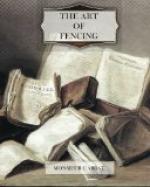to defend himself and hit you, is, that except the
Practice of Lessons be very well taught by long exercise,
you fall into a Disorder which is often owing to the
want of Art more than to any Defect in Nature.
The taking a Lesson well, and the Manner of Pushing
and Parrying which I have just described, may be attained
to by Practice only, but some other things are necessary
to make an Assault well; for besides the Turn of the
Body, the Lightness, Suppleness and Vigour which compose
the exteriour Part, you must be stout and prudent,
qualities so essential, that without them you cannot
act with a good Grace, nor to the purpose. If
you are apprehensive, besides, that you don’t
push home, or justly, fear making you keep back your
Thrust, or follow the Blade, the least Motion of the
Enemy disorders you, and puts you out of a Condition
to hit him, and to avoid his Thrusts. Without
Prudence, you cannot take the advantage of the situation,
motions designs of the enemy, which changing very
often, according to his Capacity and to the Measure,
demonstrates that an ill concerted Enterprise exposes
more to Danger than it procures Advantage: in
order to turn this Quality to an advantage, you are
to observe the Enemy’s
fort and
feeble,
whether he attack or defend; if he attack it will
be either by plain Thrusts strait, or disengaged,
or by Feints or Engagements, which may be opposed
by Time, or Ripostes: if he keeps on his Defence,
it is either to take the Time or to Riposte.
In case of the first; you shou’d, by half Thrusts,
oblige him to push in order to take a Counter to his
Time, and if he sticks to his Parade you must serve
in what Manner, in order to disorder him by Feints,
and push where he gives Light.
It would fill a whole Volume to describe the Thrusts
that may be made, according to the Difference of Persons,
as well to surprise as to avoid being surprised; besides
the many Repetitions wou’d be extremely puzzling,
for which Reason, I have, instead of them, laid down
the following Advices, which contain chiefly, what
I cou’d not otherwise have communicated without
a long Treatise.
Don’t put yourself in Guard within the Reach
of the Enemy.
Make no wry Faces, or Motions that are disagreeable
to the Sight.
Be not affected, negligent, nor stiff.
Don’t flatter yourself in your Lessons, and
still less in Assaults.
Be not angry at receiving a Thrust, but take care
to avoid it.
Be not vain at the Thrusts you give, nor shew Contempt
when you receive them.
Do not endeavour to give many Thrusts, running the
Risque of receiving one.
Don’t think yourself expert, but that you may
become so.
When you present the Foils, give the Choice without
pressing.
If you are much inferiour, make no long Assaults.
Do nothing that’s useless, every Action shou’d
tend to your Advantage.
Lessons and Assaults are only valuable when the Application
and Genius make them so.




